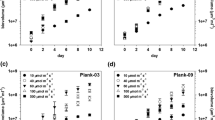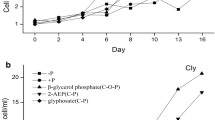Abstract
When a heterotrophic (Rhodotorula rubra) and a phototrophic (Selenastrum capricornutum) plankton were grown together in dilute phosphate (Pi) continuous cultures, coexistence occurred only when the heterotroph was growthrate limited by organic carbon (C). Because of its higher affinity for Pi, and because C starvation does not affect the heterotrophic yeast's ability to transport Pi, the concentration of organic carbon indirectly controlled the biomass of the phototroph. The results support a threshold model of microbial growth.
Similar content being viewed by others
References
Ahlgren, G.: Effects on algal growth rates by multiple nutrient limitation. Arch. Hydrobiol.89, 43–53 (1980)
Brown, E. J., and D. K. Button: Phosphate-limited growth kinetics ofSelenastrum capricornutum (Chlorophyceae). J. Phycol.15, 305–311 (1979)
Fredrickson, A. G.: Behavior of mixed cultures of microorganisms. Annu. Rev. Microbiol.31, 63–87 (1977)
Johnson, P. W., and J. McN. Sieburth: Chroococcoid cyanobacteria in the sea: A ubiquitous and diverse phototrophic biomass. Limnol. Oceanogr.24, 929–935 (1979)
Keating, K. I.: Allelopathic influence on blue-green bloom sequence in a eutrophic lake. Science196, 885–887 (1977)
Murphy, J., and J. P. Riley: A modified single solution method for the determination of phosphate in natural waters. Anal. Chem. Acta27, 31–36 (1962)
Nyholm, N.: A mathematical model for microbial growth under limitation by conservative substrates. Biotechnol. Bioeng.18, 1043–1056 (1976)
Rhee, G.-Y.: Competition between an alga and an aquatic bacterium for phosphate. Limnol. Oceanogr.17, 505–514 (1972)
Rhee, G.-Y.: Effects of N∶P atomic ratios and nitrate limitation on algal growth, cell composition, and nitrate uptake. Limnol. Oceanogr.23, 10–25 (1978)
Robertson, B. R., and D. K. Button: The phosphate-limited continuous culture ofRhodotorula rubra: kinetics of transport, leakage and growth. J. Bacteriol.138, 884–895 (1979)
Saks, N. M., and E. G. Kahn: Substrate competition between a salt marsh diatom and a bacterial population. J. Phycol.15, 17–21 (1979)
Schindler, D. W.: Whole lake eutrophication experiments with phosphorus, nitrogen and carbon. Verh. Int. Verein. Limnol.19, 3221–3231 (1975)
Schlinder, D. W.: Evolution of phosphorus limitation in lakes. Science195, 260–262 (1977)
Tempest, D. W., and O. M. Neijssel: Eco-physiological aspects of microbial growth in aerobic nutrient-limited environments. In M. Alexander, (ed.): Advances in Microbial Ecology, Vol. 2, pp. 105–153. Plenum Press, New York (1978)
Author information
Authors and Affiliations
Rights and permissions
About this article
Cite this article
Brown, E.J., Button, D.K. & Lang, D.S. Competition between heterotrophic and autotrophic microplankton for dissolved nutrients. Microb Ecol 7, 199–206 (1981). https://doi.org/10.1007/BF02010303
Issue Date:
DOI: https://doi.org/10.1007/BF02010303




